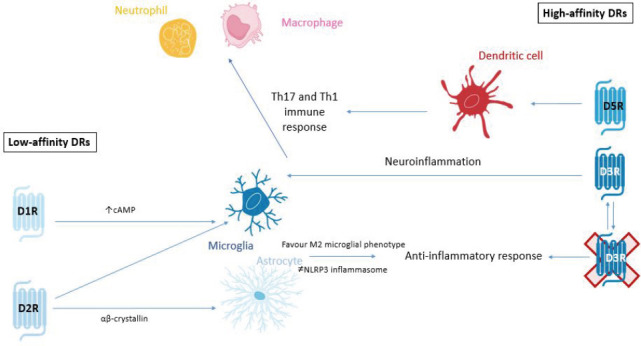Figure 4.

Summary of low-affinity and high-affinity actions of DRs.
In Parkinson's disease and PD models pro-inflammatory signaling has been shown to be mediated by high affinity D3 and D5 receptors. The RHS of the image shows the signaling of high-affinity receptors D3R and D5R. D3Rs on glial cells promote neuroinflammation but also secrete pro-inflammatory cytokines that activate Th17 and Th1 immune responses in CD4+ T cells which promotes the recruitment of neutrophils and macrophages to the inflammatory site. Furthermore, dopamine acting on D5R stimulates dendritic cells to acquire the Th17 pro-inflammatory phenotype. Moreover, in PD, it has been shown that D1 agonism promotes anti-inflammatory response through increase of cAMP and favoring of M2 microglia phenotype and inhibition of NLRP3 inflammasome. Also, D2 agonists acting on astrocytes and microglia inhibits NLRP3 inflammasome (via ab crystallin signaling in astrocytes). The inhibition of D3R has been shown to attenuate inflammation and subsequent degeneration in MPTP mouse models of PD. cAMP: Cyclic adenosine monophosphate; DR: dopamine receptor; MPTP: 1-methyl- 4-phenyl-1,2,3,6-tetrahydropyridine; NLRP3: Nod-like receptor containing a pyrin domain 3; PD: Parkinson's disease.
